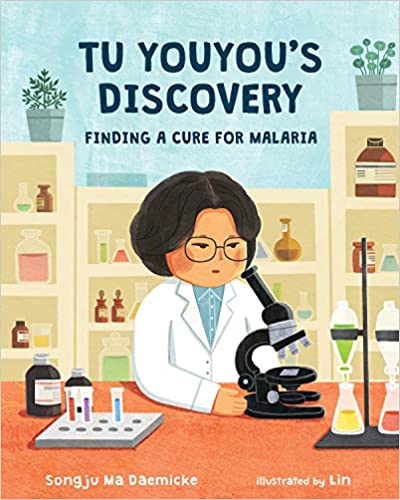Finding a Cure for Malaria
by Songju Ma Daemicke
illustrated by Lin
Albert Whitman & Company, 2021. 32 pages.
Review written November 29, 2021, from a library book
Starred Review
Tu Youyou’s Discovery is a picture book that tells the story of how a Chinese lady born in 1930 studied Chinese Traditional Medicine in her modern research lab, and through much hard work discovered a cure for malaria. In 2015, she received the Nobel Prize in Medicine, becoming the first Chinese woman to win a Nobel Prize of any kind.
The story of her life and work is simply told in understandable terms. It tells about her research and stories in traditional medicine of an herbal remedy that sounded promising – but how it didn’t work in her many lab trials.
I like this part, told over four pages with simple illustrations:
Still, the experiments kept failing – more than one hundred with no success.
Some male researchers began to question Youyou’s leadership and doubt the direction of her research. Western countries with advanced technologies hadn’t found a cure. Was using herbal medicine to cure malaria an impossible goal?
But Youyou was stubborn. Her faith in traditional Chinese medicine was unshakable. She kept working and testing.
Then something incredible happened.
After 190 unsuccessful experiments, the test result of sample 191 stunned the team. The qinghao extract prepared at a temperature of only 94 degrees Fahrenheit had killed the parasites completely!
The note at the back tells us that this new therapy saved 6.8 million lives between 2001 and 2015. At the back, there’s also a section “Tu Youyou and the Scientific Method” listing the steps of the Scientific Method and how they were used by Tu Youyou’s team.
A lovely story of a remarkable female scientist.
songjumadaemicke.com
albertwhitman.com
This review is only on the blog.
Disclosure: I am an Amazon Affiliate, and will earn a small percentage if you order a book on Amazon after clicking through from my site.
Disclaimer: I am a professional librarian, but the views expressed are solely my own, and in no way represent the official views of my employer or of any committee or group of which I am part.
What did you think of this book?
